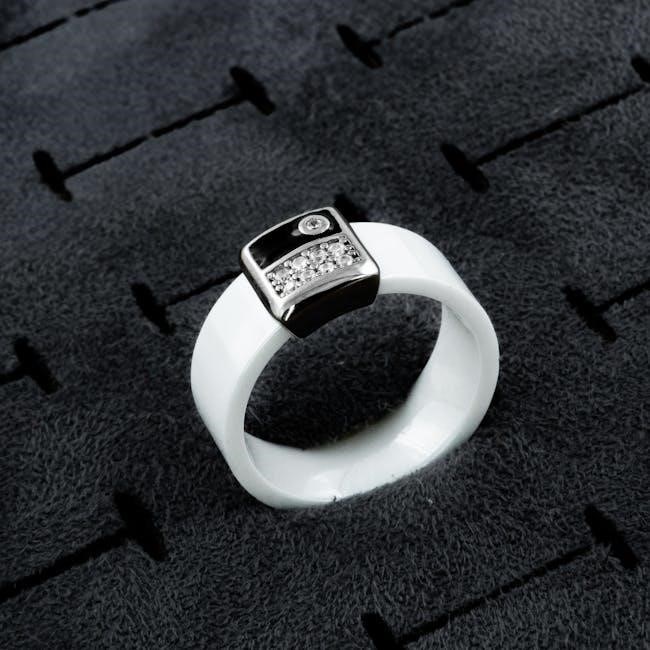This comprehensive guide explores Guy de Maupassant’s “The Jewelry,” a poignant tale of love, loss, and deception, alongside practical jewelry-making techniques and cultural insights into jewelry’s significance.
Overview of the Topic
The topic revolves around “The Jewelry PDF,” a comprehensive resource that delves into Guy de Maupassant’s short story The Jewelry, alongside detailed guides on jewelry crafting and cultural insights. The PDF explores the narrative of M. Lantin, a clerk whose life takes a dramatic turn due to his wife’s fascination with imitation jewelry, revealing themes of deception and materialism. Additionally, the document provides practical tutorials on jewelry making, such as wire jewelry techniques and beaded designs, catering to both beginners and seasoned crafters. It also examines the historical and cultural significance of jewelry, from vintage pieces to modern trends, highlighting its role in art, fashion, and identity. The PDF further discusses technological advancements in jewelry manufacturing, including CAD design and 3D printing, offering a blend of literary analysis and hands-on craftsmanship. This resource is ideal for literature enthusiasts, jewelry makers, and anyone interested in the intersection of art and culture.
Importance of Jewelry in Literature and Culture
Jewelry holds a profound significance in both literature and culture, often serving as a symbol of wealth, status, and identity. In Guy de Maupassant’s The Jewelry, it becomes a central motif, reflecting themes of deception and materialism. Historically, jewelry has been a cornerstone of cultural expression, with ancient civilizations using it to signify power and spiritual beliefs. In modern times, it continues to influence fashion, with designers drawing inspiration from architectural and artistic movements. The PDF highlights how jewelry transcends its decorative purpose, embodying emotional and societal values. It also explores the evolution of jewelry-making techniques, from traditional craftsmanship to cutting-edge technologies like CAD design. By examining jewelry’s role in literature and culture, the PDF offers insights into its enduring impact on human history and identity, making it a vital resource for understanding its artistic and symbolic significance across generations.
Structure and Content of the PDF
The PDF is structured to provide a holistic understanding of jewelry, blending literary analysis with practical guides. It begins with an introduction to Guy de Maupassant’s The Jewelry, exploring its themes and cultural relevance. The document then transitions into detailed tutorials on jewelry-making techniques, such as wire jewelry and beaded designs, offering step-by-step instructions for crafters. Additionally, it delves into advanced manufacturing processes, including CAD subsystems and 3D printing, highlighting their impact on modern jewelry production. The PDF also features sections on historical and contemporary jewelry trends, showcasing collections like high jewelry and vintage pieces. Cultural insights are provided, emphasizing jewelry’s role in identity and art. The document concludes with a discussion on the future of jewelry manufacturing, blending tradition with innovation. Visual aids, such as thumbnails and diagrams, complement the text, making it a comprehensive resource for both enthusiasts and professionals in the field of jewelry.
Guy de Maupassant’s “The Jewelry”
M. Lantin’s seemingly idyllic marriage turns tragic when his young wife dies, revealing her shocking secret. The story explores themes of love, deception, and societal illusions through its poignant narrative.
Plot Summary and Main Characters

Guy de Maupassant’s “The Jewelry” tells the story of M. Lantin, a chief clerk at the Minister of Interior’s office in Paris. He marries a young, innocent woman, and they enjoy a seemingly happy marriage for six years. Tragically, she dies of pneumonia, leaving M. Lantin heartbroken. After her death, he discovers her fascination with imitation jewelry, which shocks him. The story revolves around themes of love, loss, and deception, with M. Lantin as the central character. His wife’s character is revealed through her love for theater and imitation jewelry, which contrasts with her otherwise simple and devoted nature. The narrative explores the complexities of human relationships and the illusions that often accompany them. The story is a poignant reflection on life, death, and the secrets that bind us. The characters are well-defined, with M. Lantin’s journey from happiness to grief serving as the emotional core of the tale.
Themes and Symbolism in the Story
Guy de Maupassant’s “The Jewelry” delves into themes of deception, illusion, and the duality of human nature. The imitation jewelry symbolizes the superficiality of appearances and the hidden truths beneath them. M. Lantin’s wife, seemingly innocent and devoted, harbors a secret passion for theater and fake jewelry, reflecting her inner contradictions. The story critiques societal norms, where people often conceal their true selves to fit expectations. The jewelry serves as a metaphor for the artificiality of life, highlighting how individuals create illusions to cope with reality. The narrative also explores the tension between love and materialism, as M. Lantin grapples with his wife’s unexpected fascination with trinkets. The interplay of truth and deception underscores the complexity of human relationships, while the jewelry itself becomes a powerful symbol of the masks people wear in life.
Historical Context of the Narrative
Guy de Maupassant’s “The Jewelry” is set in 19th-century Paris, a time of societal transformation and cultural shifts. The story reflects the Belle Époque’s influence, where luxury and appearances dominated middle-class aspirations. M. Lantin’s role as a chief clerk highlights the growing importance of bureaucracy and the rise of the middle class. The narrative critiques the social norms of the era, particularly the emphasis on material possessions and the illusion of wealth. The character of M. Lantin’s wife, with her love for imitation jewelry, symbolizes the broader societal obsession with status and the blurring of authenticity. The historical context also touches on the restricted roles of women, as her desires are confined by societal expectations. The story’s Parisian setting underscores the city’s role as a hub of cultural and economic change, where traditions clashed with modernity. Maupassant’s critique of these dynamics offers a poignant commentary on the hypocrisies of his time.
Analysis of the Protagonist’s Journey
M. Lantin’s journey in “The Jewelry” is a transformative exploration of love, loss, and self-discovery. Initially, he embodies the ideals of a devoted husband, deeply in love with his wife and seemingly content with their modest life. However, her untimely death shatters his world, revealing a darker truth about her infidelity and obsession with imitation jewelry. This revelation forces Lantin to confront his own naivety and the societal illusions he once accepted. Through his grief and anger, he undergoes a profound shift in perspective, questioning the authenticity of relationships and the value placed on material possessions. Ultimately, Lantin’s journey is one of disillusionment and growth, as he learns to navigate a world where appearances often mask reality. Maupassant’s portrayal of Lantin’s transformation offers a nuanced commentary on the human condition, highlighting the fragility of trust and the enduring impact of deception.

Jewelry Making Guides
Discover essential tutorials and techniques for crafting stunning jewelry, from wire art to beaded designs, using CAD systems and quality materials to create timeless pieces for beginners and experts alike.
Wire Jewelry Tutorials and Techniques
Master the art of wire jewelry making with detailed tutorials and expert techniques. Learn to craft intricate designs using copper, silver, and gold wires. Discover how to shape, bend, and texture wire to create unique pieces. From basic wraps to complex weaves, these guides offer step-by-step instructions for all skill levels. Explore projects ranging from delicate earrings to bold statement necklaces. Essential tools like wire cutters, pliers, and hammers are highlighted, ensuring you have everything needed to get started. Whether you’re a beginner or an experienced crafter, these tutorials will help you unlock your creativity and produce professional-quality wire jewelry. Elevate your craftsmanship with tips on finishing techniques and design inspiration. Perfect for those seeking hands-on guidance to refine their wireworking skills and create stunning, wearable art.
Beaded Jewelry Patterns and Designs
Explore a wide variety of beaded jewelry patterns and designs tailored for both beginners and intermediate crafters. These tutorials, such as those by Yuliya Abelovich, offer step-by-step guides for creating stunning pieces using multi-hole beads and seed beads. Learn how to craft intricate designs, from simple bracelets to elaborate necklaces. Discover techniques for combining different bead types, colors, and textures to create unique and eye-catching jewelry. The guide includes detailed instructions for various stitching methods, such as peyote and herringbone, ensuring versatility in your designs. Perfect for those looking to expand their beading skills, these patterns inspire creativity and precision. With clear illustrations and easy-to-follow instructions, you can master the art of beaded jewelry making and create beautiful, professional-quality pieces. Whether for personal enjoyment or as gifts, these designs offer endless possibilities for artistic expression.
CAD Subsystem in Jewelry Manufacturing
The CAD (Computer-Aided Design) subsystem has revolutionized jewelry manufacturing by enabling precise and intricate designs. This technology allows designers to create detailed digital models of jewelry pieces, streamlining the production process. With CAD, artisans can experiment with complex shapes and patterns, ensuring accuracy and consistency. The system also facilitates customization, enabling clients to visualize and modify designs in real-time. By integrating 3D printing, CAD further enhances manufacturing efficiency, reducing errors and production time. This digital approach has become indispensable in modern jewelry making, blending traditional craftsmanship with cutting-edge innovation. Whether crafting high-end jewelry or intricate beaded designs, the CAD subsystem plays a pivotal role in bringing creative visions to life. Its versatility and precision make it an essential tool for both small-scale artisans and large-scale manufacturers, ensuring high-quality and innovative jewelry piece production.
Materials and Tools for Jewelry Crafting
Jewelry crafting requires a variety of materials and tools to bring designs to life. Common materials include beads, wires, metals (like gold, silver, and platinum), and gemstones. Beaders often use seed beads, multi-hole beads, and rondelle beads for intricate patterns. For wire jewelry, copper, brass, and sterling silver wires are popular due to their malleability. Tools like wire cutters, round-nose pliers, and flat-nose pliers are essential for shaping and bending. A workbench or jeweler’s block provides a stable workspace, while a torch is used for soldering and annealing. Additional tools include jump rings, head pins, and findings such as clasps and earring backs. For beaded projects, beading needles and threads like nylon or waxed cord are indispensable. Safety gear, such as gloves and goggles, is crucial when working with sharp objects or heat. These materials and tools enable artisans to craft everything from simple wire bracelets to complex beaded necklaces, blending creativity with technical precision.

Jewelry Types and Collections
Jewelry encompasses diverse types, from high jewelry’s intricate craftsmanship to vintage pieces with historical charm. Modern trends feature contemporary designs, while platinum and gold collections exude timeless luxury and sophistication.
High Jewelry and Its Craftsmanship
High jewelry is a celebration of exceptional craftsmanship, blending artistic vision with technical mastery. Renowned collections like ONesto High Jewelry and PER SEMPRE showcase intricate designs, often featuring rare diamonds and precious gemstones. These pieces are not merely accessories but works of art, reflecting a deep understanding of luxury and elegance. The craftsmanship involves meticulous attention to detail, with techniques such as micro-pavé setting and hand-engraving. High jewelry also emphasizes the use of ethically sourced materials, ensuring both beauty and sustainability. Each piece tells a story, combining tradition with modern innovation. For instance, the PLATINA Jewelry collection highlights platinum’s durability and versatility, while PLATIKA Jewelry explores bold, contemporary aesthetics. These creations are treasured not only for their monetary value but also for their emotional and cultural significance, making high jewelry a timeless expression of sophistication and artistry.
Vintage and Antique Jewelry
Vintage and antique jewelry are treasured for their historical significance, craftsmanship, and unique designs. These pieces often reflect the cultural and artistic movements of their time, such as Art Nouveau or Victorian styles. Antique jewelry, typically over 100 years old, showcases techniques like hand-engraving and filigree, while vintage pieces from the 1920s to the 1980s often feature bold, geometric patterns and ornate details. The resurgence of interest in vintage jewelry has led to its inclusion in modern fashion, blending timeless elegance with contemporary trends. Collectors and enthusiasts value these items for their rarity and historical narratives, as each piece carries a story of its past. Vintage jewelry also offers a sustainable alternative to fast fashion, promoting the reuse and appreciation of craftsmanship from bygone eras. Whether adorned with pearls, diamonds, or other gemstones, vintage and antique jewelry remains a testament to the evolution of art and style over centuries.
Modern and Contemporary Jewelry Trends
Modern and contemporary jewelry trends reflect a fusion of innovation, sustainability, and cultural influences. Designers today experiment with unconventional materials like recycled metals, lab-grown diamonds, and organic elements. Minimalist designs with clean lines and subtle details have gained popularity, offering versatility for everyday wear. At the same time, bold statement pieces with vibrant colors and asymmetrical shapes continue to captivate, blending artistry with functionality. Sustainability plays a significant role, with ethical sourcing of gemstones and eco-friendly production methods becoming integral to modern jewelry-making. Digital tools and 3D printing have also revolutionized the industry, enabling intricate designs that were once impossible to craft by hand. Contemporary trends often draw inspiration from historical periods, such as the geometric patterns of the 1920s or the organic forms of the 1970s, reimagined with a modern twist. This dynamic interplay between tradition and innovation defines the ever-evolving landscape of modern jewelry, making it a testament to creativity and cultural expression.
Platinum and Gold Jewelry Collections

Platinum and gold jewelry collections are renowned for their timeless elegance and luxurious appeal. Platinum, with its striking white luster, is often used in high jewelry pieces, symbolizing sophistication and durability. Gold, available in yellow, white, and rose hues, offers versatility and warmth, making it a favorite for both classic and contemporary designs. These precious metals are prized for their rarity and craftsmanship, often featuring intricate detailing and gemstone embellishments. Collections like “ONESTO HIGH JEWELRY” and “PLATINA JEWELRY” showcase masterpieces that blend tradition with modern aesthetics. Platinum and gold jewelry is not only a statement of wealth but also a celebration of artistry, with many pieces becoming family heirlooms. Their durability ensures they retain value over generations, making them a cherished investment in beauty and legacy. Whether for weddings, anniversaries, or everyday wear, platinum and gold jewelry collections continue to captivate with their enduring allure and emotional significance.
Jewelry in Art and Design

Jewelry serves as a canvas for artistic expression, blending cultural influences, architectural motifs, and historical inspirations; It reflects societal values, with designs evolving through movements like Art Nouveau and Modernism, shaping identity and fashion.
Influence of Jewelry on Fashion
Jewelry has long been a cornerstone of fashion, transcending mere adornment to become a statement of identity and style. Its influence is evident in how it complements outfits, reflecting cultural and historical contexts. From intricate Art Nouveau designs to minimalist modern pieces, jewelry adapts to fashion trends, enhancing overall aesthetics. It serves as a medium for self-expression, allowing individuals to convey their personality and values. The interplay between jewelry and clothing creates a harmonious balance, elevating fashion to an art form. This synergy is celebrated in high-end couture and everyday wear alike, making jewelry an indispensable element in the ever-evolving landscape of fashion.
Architectural Inspiration in Jewelry Design

Architectural elements have profoundly influenced jewelry design, creating pieces that mirror iconic structures and geometric patterns. Designers draw inspiration from historical and modern architecture, translating intricate details into wearable art. For instance, Art Deco jewelry often features symmetrical lines and angular forms, reminiscent of skyscrapers and monumental buildings. The use of materials like steel, titanium, and 3D-printed plastics further bridges the gap between architecture and jewelry. Architects and jewelers collaborate to craft pieces that reflect cultural and historical contexts, blending functionality with aesthetic appeal. This fusion highlights the shared goal of creating timeless, visually striking designs. By embracing architectural principles, jewelry becomes a miniature celebration of structural artistry, connecting the wearer to broader cultural narratives. This interdisciplinary approach continues to evolve, pushing the boundaries of both fields and inspiring innovative creations.
The Role of Jewelry in Cultural Identity

Jewelry serves as a profound expression of cultural identity, reflecting a community’s values, traditions, and history. Across the world, unique jewelry styles embody the essence of their origins, often passing down through generations. For instance, the Kuchi people’s jewelry, adorned with intricate patterns and symbolic motifs, tells stories of their nomadic heritage and resilience. Similarly, ancient jewelry techniques, preserved and evolved, connect modern artisans to their ancestors. Jewelry also acts as a unifying force, fostering pride and belonging among community members. Its role extends beyond aesthetics; it is a tangible link to cultural roots, preserving history and traditions in an ever-changing world. Through jewelry, cultures celebrate their distinctiveness, ensuring their legacy endures for future generations. This art form bridges past and present, making it a vital component of cultural identity globally.

Artistic Movements and Jewelry Evolution
Artistic movements have profoundly shaped jewelry design, reflecting the cultural and aesthetic shifts of their eras. The 1920s, for instance, saw a surge in geometric patterns and bold motifs, influenced by Art Deco, which became iconic in jewelry craftsmanship. Similarly, the organic curves of Art Nouveau inspired intricate jewelry pieces that celebrated natural forms. Modern and contemporary jewelry trends embrace minimalism and sustainability, often incorporating innovative materials like recycled metals and conflict-free diamonds. Digital tools, such as CAD design and 3D printing, have further revolutionized jewelry creation, enabling precise and complex designs. These advancements have allowed artisans to experiment with new techniques, blending tradition with modernity. As a result, jewelry continues to evolve, serving as both a wearable art form and a testament to the creative spirit of its time. This fusion of historical influence and cutting-edge technology ensures jewelry remains a dynamic and ever-changing art form.

Jewelry and Technology
Technology has transformed jewelry making, with CAD design enabling precise craftsmanship and 3D printing revolutionizing production. Digital tools enhance creativity, while innovative materials and techniques ensure sustainability and modernity in jewelry manufacturing.
CAD Design in Jewelry Creation
CAD (Computer-Aided Design) has revolutionized jewelry creation, enabling designers to craft intricate and precise designs with unmatched accuracy. By leveraging advanced software, jewelers can create detailed 3D models, simulate finishes, and experiment with various materials virtually. This technology streamlines the design process, reducing production time and errors. CAD also facilitates customization, allowing clients to visualize and modify designs before manufacturing. The integration of CAD subsystems in jewelry manufacturing ensures consistency and scalability, making it a cornerstone of modern jewelry production. Additionally, CAD tools enhance collaboration between designers and manufacturers, fostering innovation and efficiency. With CAD, the boundaries of creativity expand, enabling the creation of complex and visually stunning pieces that were once difficult to achieve by hand. This technological advancement has transformed the jewelry industry, blending artistry with precision to meet evolving market demands. CAD design continues to play a pivotal role in shaping the future of jewelry creation.
3D Printing and Its Impact on Jewelry Making
3D printing has emerged as a groundbreaking technology in jewelry making, offering unparalleled precision and creativity. This innovative method allows designers to produce intricate designs with complex geometries that were previously difficult or impossible to achieve by hand. By layering materials like resin or metal, 3D printing enables the creation of customized jewelry with exceptional detail and accuracy. This technology not only accelerates production but also reduces waste and lowers costs, making it a sustainable option for manufacturers. Additionally, 3D printing empowers jewelers to experiment with unique designs and materials, pushing the boundaries of artistic expression. Its ability to produce prototypes quickly facilitates faster iteration and refinement, ensuring high-quality final products. As a result, 3D printing is transforming the jewelry industry, enabling the creation of intricate, bespoke pieces that cater to diverse tastes and preferences; This technology is poised to play a central role in the future of jewelry manufacturing, blending tradition with modern innovation.
Digital Tools for Jewelry Designers
Digital tools have revolutionized jewelry design, offering unparalleled precision and creativity. Software like CAD (Computer-Aided Design) and CounterSketch Studio enable designers to create intricate designs with ease. These tools allow for real-time rendering, enabling designers to visualize pieces in 3D before production. Digital platforms also facilitate customization, letting clients preview and modify designs virtually. Additionally, digital tools streamline the design process, reducing errors and saving time. Many programs, such as Matrix and ZBrush, offer advanced features for intricate detailing and texture manipulation. Digital libraries of pre-designed elements further enhance creativity, while cloud-based solutions allow collaboration across teams. These tools not only improve efficiency but also open up new possibilities for innovative jewelry design, making them indispensable in modern jewelry creation. As technology advances, digital tools continue to play a vital role in shaping the future of the jewelry industry.
The Future of Jewelry Manufacturing
The future of jewelry manufacturing is poised for transformation through advanced technologies and sustainable practices. CAD design and 3D printing are reshaping production, enabling rapid prototyping and complex designs. These tools enhance precision and reduce material waste, making the process more efficient. Additionally, the use of recycled metals and ethically sourced materials is gaining prominence, aligning with consumer demand for sustainability. Digital platforms are also streamlining manufacturing workflows, from design to production, ensuring consistency and quality. As technology evolves, jewelry manufacturing is expected to become more eco-friendly and innovative, catering to diverse consumer preferences. The integration of AI and machine learning could further optimize production processes. With a focus on sustainability and technological advancement, the jewelry industry is set to embrace a future that balances tradition with modern innovation.
